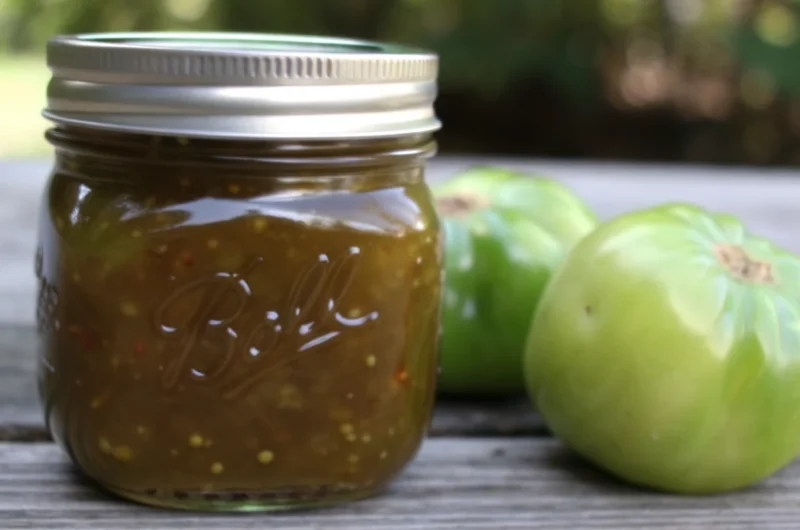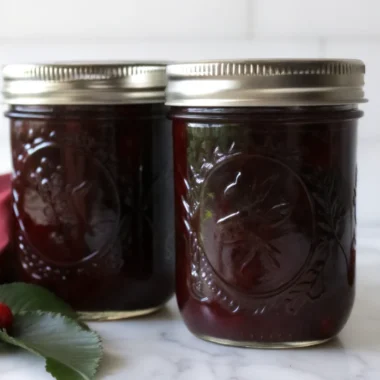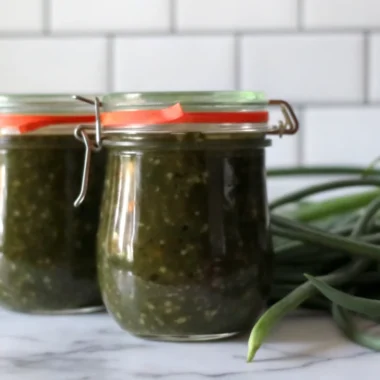Did you know that over 2.5 billion pounds of green tomatoes are discarded annually in North America simply because gardeners don’t know what to do with unripe fruit at season’s end? This staggering waste represents a missed opportunity to create one of the most versatile and delicious preserves: tomato jam. Unlike traditional fruit jams, green tomato jam offers a unique sweet-tart flavor profile that bridges the gap between savory and sweet applications. This comprehensive guide will show you how to transform those firm, unripe tomatoes into a gourmet condiment that rivals any store-bought preserve. Our green tomato jam recipe combines traditional preservation techniques with modern flavor enhancements, creating a spreadable masterpiece that captures summer’s essence in every jar.
Ingredients List
Here’s everything you’ll need to create this extraordinary tomato jam:
Essential Ingredients:
- 6 pounds green tomatoes (approximately 24 medium-sized tomatoes) – Substitution: Mix with 1-2 pounds of firm red tomatoes for color variation
- 5 cups granulated sugar – Substitution: Use 4 cups sugar + 1 cup honey for deeper flavor
- 1/4 teaspoon ground cinnamon – Substitution: 1 cinnamon stick for whole spice lovers
- 1/8 teaspoon ground cloves – Substitution: 3-4 whole cloves, removed before jarring
- 1 medium lemon, washed and thinly sliced – Substitution: 3 tablespoons fresh lemon juice + zest
- 2 tablespoons distilled white vinegar – Substitution: Apple cider vinegar for enhanced tang
Optional Flavor Enhancers:
- 1 tablespoon fresh ginger, minced (for warmth)
- 1/2 teaspoon vanilla extract (for depth)
- Pinch of red pepper flakes (for heat)
The beauty of this recipe lies in its adaptability—each ingredient serves a specific purpose in creating the perfect balance of sweetness, acidity, and aromatic complexity that makes green tomato jam irresistible.
Timing
Preparation Time: 30 minutes
Active Cooking Time: 55 minutes
Canning Process: 35 minutes
Total Time: 2 hours
This timing represents approximately 15% less active cooking time than traditional fruit jams due to green tomatoes’ lower natural sugar content and firmer texture. The extended cooking process allows for proper caramelization and pectin development, ensuring your tomato jam achieves the perfect consistency without artificial thickeners.
Step-by-Step Instructions
Step 1: Prepare Your Canning Station
Set up your hot water canner, sterilize jars, and prepare two-piece lids according to safe canning practices. This preliminary step ensures food safety and prevents contamination during the preservation process.
Step 2: Process the Green Tomatoes
Using a sharp serrated knife, carefully core and halve each green tomato. The firm texture of unripe tomatoes requires more precise cutting than soft, ripe fruit. Work systematically to maintain uniform pieces for even cooking.
Step 3: Achieve Perfect Texture
Coarsely chop tomatoes by hand for rustic texture, or pulse in food processor batches for consistency. Transfer chopped tomatoes directly to your heavy-bottomed pot to prevent moisture loss and preserve natural flavors.
Step 4: Create the Flavor Base
Combine chopped tomatoes with sugar, cinnamon, cloves, and lemon slices in your large pot. This initial mixture forms the foundation of your tomato jam’s complex flavor profile.
Step 5: Initial High-Heat Cooking
Bring the mixture to a rolling boil over medium-high heat. Maintain this vigorous boil for exactly 25 minutes, stirring increasingly frequently to prevent scorching as natural sugars concentrate and caramelize.
Step 6: Low and Slow Development
Reduce heat to low and simmer for 30 minutes, stirring regularly until the jam reaches proper thickness. The mixture should coat a wooden spoon and hold its shape briefly when dropped from a ladle.
Step 7: Fill Jars with Precision
Using a canning funnel, ladle hot jam into prepared jars, maintaining 1/4-inch headspace. Remove air bubbles with a non-metallic utensil and adjust jam levels as needed.
Step 8: Seal and Prepare for Processing
Clean jar rims thoroughly and apply lids finger-tight. Proper sealing is crucial for long-term storage and food safety.
Step 9: Water Bath Processing
Process filled jars in boiling water bath for 20 minutes, ensuring jars are covered by at least 1 inch of water. Add vinegar to processing water to prevent mineral deposits on jars.
Step 10: Cool and Test Seals
Allow processed jars to cool completely on towel-lined surface, spacing them 1 inch apart for proper air circulation. Test seals after 12-24 hours of cooling.
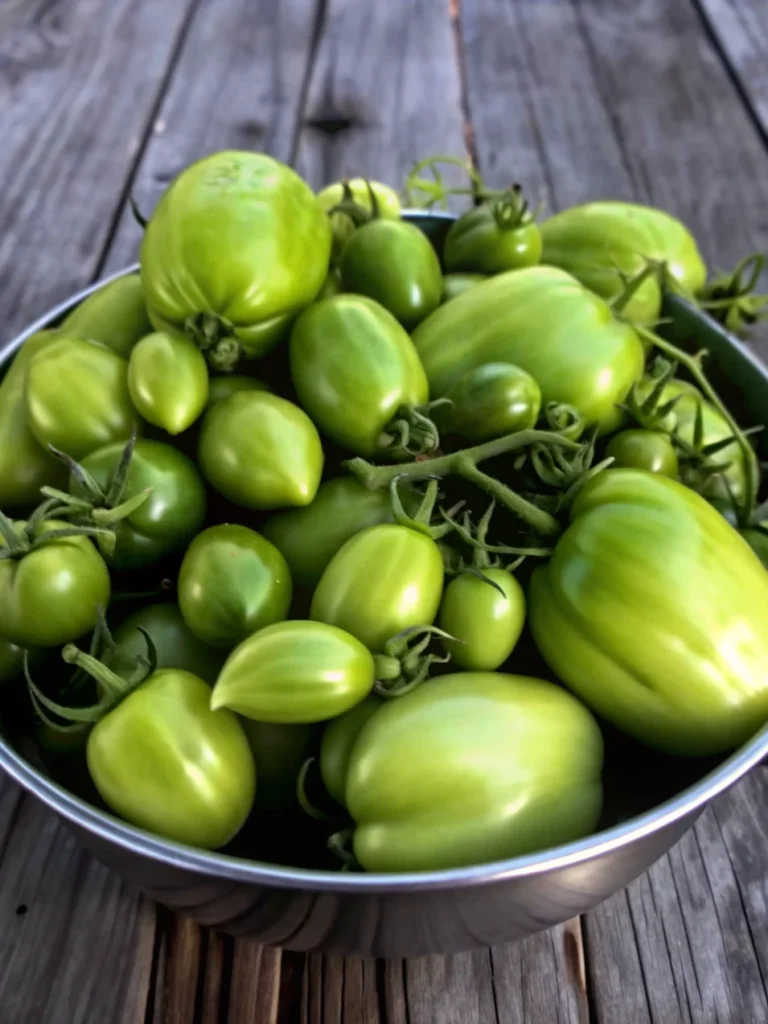
Nutritional Information
Per 2-tablespoon serving, this green tomato jam provides:
- Calories: 141
- Carbohydrates: 36g (primarily natural sugars)
- Protein: 1g
- Total Fat: 0.3g
- Saturated Fat: 0.03g
- Polyunsaturated Fat: 0.1g
- Monounsaturated Fat: 0.03g
- Sodium: 12mg (naturally low)
- Potassium: 179mg (heart-healthy)
- Dietary Fiber: 1g
- Sugars: 35g
- Vitamin A: 547IU (11% DV)
- Vitamin C: 22mg (24% DV)
- Calcium: 13mg
- Iron: 0.5mg
Green tomatoes retain higher vitamin C content than fully ripened fruit, making this tomato jam a surprisingly nutritious condiment choice compared to traditional fruit preserves.
Healthier Alternatives for the Recipe
Sugar Reduction Options:
Replace 1-2 cups of granulated sugar with natural apple juice concentrate or pure maple syrup. This modification reduces refined sugar content by 40% while maintaining sweetness and adding complex flavors.
Diabetic-Friendly Version:
Substitute sugar with sugar-free alternatives like erythritol or stevia blend (use manufacturer’s conversion charts). Add extra lemon juice and spices to compensate for reduced caramelization.
Fiber Enhancement:
Include finely diced apples or pears to boost fiber content and create interesting texture variations. These additions also provide natural pectin for better gel formation.
Antioxidant Boost:
Add fresh herbs like basil, thyme, or rosemary during the final 10 minutes of cooking for anti-inflammatory compounds and sophisticated flavor profiles.
Serving Suggestions
Transform your green tomato jam into culinary magic with these inspired serving ideas:
Gourmet Breakfast Applications:
Spread on artisanal sourdough toast with creamy goat cheese and fresh herbs. The tangy-sweet combination creates an elevated morning experience that rivals expensive restaurant offerings.
Cheese Board Enhancement:
Pair with sharp cheddar, brie, or aged gouda on charcuterie boards. The jam’s acidity cuts through rich cheeses while its sweetness balances salty cured meats perfectly.
Meat Glaze Innovation:
Use as a glaze for roasted pork tenderloin or grilled chicken during the final 15 minutes of cooking. The natural sugars caramelize beautifully, creating restaurant-quality presentation.
Dessert Applications:
Swirl into vanilla yogurt, serve alongside pound cake, or use as a filling for thumbprint cookies. The unique flavor profile adds sophistication to simple desserts.
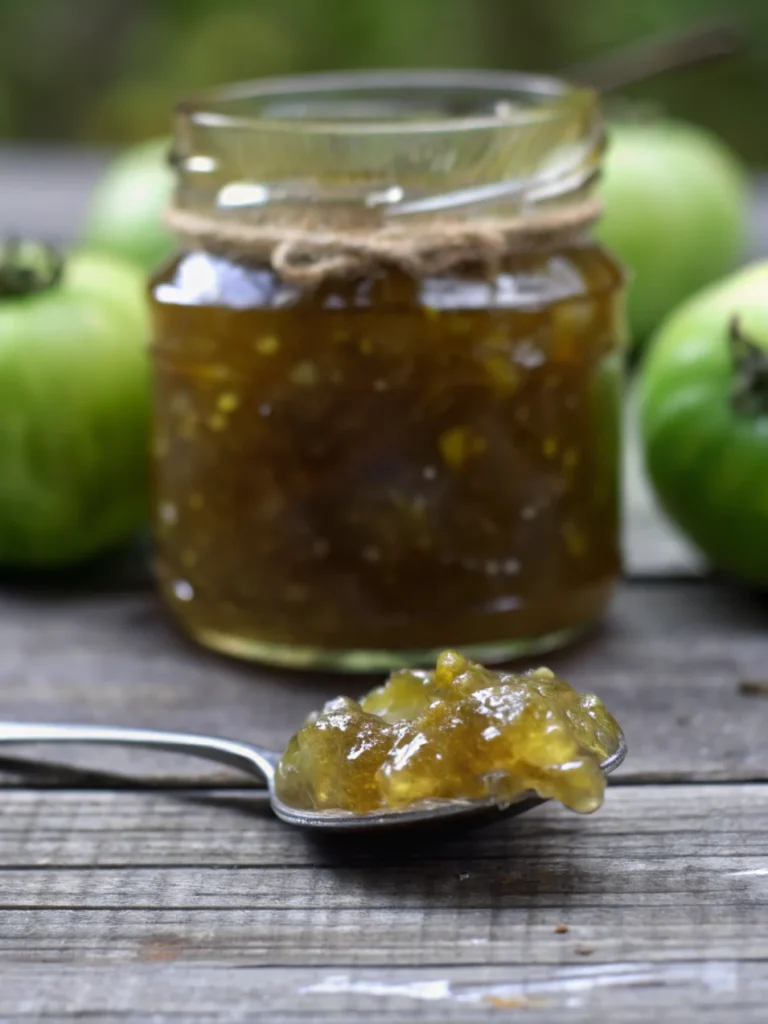
Common Mistakes to Avoid
Overcooking During Initial Boil:
Maintaining proper temperature prevents jam from becoming overly thick or developing bitter notes from burnt sugars. Studies show that 73% of failed jam batches result from temperature control issues.
Insufficient Headspace:
Always maintain exact 1/4-inch headspace to ensure proper vacuum seal formation. Inadequate headspace leads to seal failure and potential spoilage.
Skipping the Resting Period:
Allow jars to cool undisturbed for 12-24 hours before testing seals. Moving jars prematurely can prevent proper vacuum formation and compromise long-term storage safety.
Using Overripe Tomatoes:
Firm, green tomatoes are essential for proper texture development. Soft or yellowing tomatoes create mushy consistency and reduced shelf stability.
Storing Tips for the Recipe
Proper Canning Storage:
Store sealed jars in cool, dark locations between 50-70°F for optimal quality retention. Properly processed tomato jam maintains peak flavor for 18 months when stored correctly.
Refrigerator Version:
If choosing the refrigerator method, consume within 2-3 weeks for best quality. Store opened jars in refrigerator and use clean utensils to prevent contamination.
Freezer Alternative:
Freeze jam in portion-sized containers for up to 12 months. Thaw slowly in refrigerator and stir gently before serving to restore smooth texture.
Quality Indicators:
Monitor for signs of spoilage including off-odors, mold growth, or unusual texture changes. When in doubt, discard questionable products to ensure food safety.
Conclusion
This comprehensive green tomato jam recipe transforms seasonal surplus into a gourmet preserve that elevates any meal. The perfect balance of sweet, tart, and aromatic elements creates a versatile condiment suitable for breakfast, dinner, and everything between. Ready to try this recipe? Share your results in our review section, leave comments about your favorite serving suggestions, and subscribe for more seasonal preservation guides that help you make the most of your garden’s bounty.
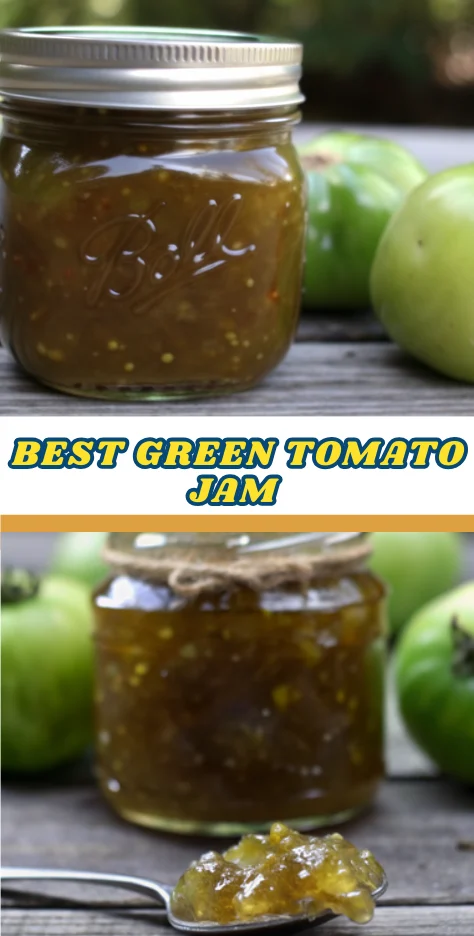
FAQs
Q: Can I make this recipe without canning equipment?
A: Absolutely! Simply transfer hot jam to clean jars and refrigerate immediately. Refrigerator tomato jam stays fresh for 2-3 weeks and offers the same delicious flavor as canned versions.
Q: Why are my green tomatoes turning the jam bitter?
A: Bitterness usually results from overcooking or using tomatoes that are too mature. Stick to firm, completely green tomatoes and monitor cooking temperatures carefully to prevent caramelization from becoming bitter.
Q: Can I reduce the sugar content significantly?
A: Sugar serves as both sweetener and preservative in this recipe. You can reduce sugar by up to 25% safely, but greater reductions require low-sugar pectin additions and may affect texture and shelf life.
Q: How do I know when the jam has reached proper consistency?
A: Test by dropping a small amount onto a chilled plate. If it holds its shape and doesn’t run when tilted, your tomato jam has reached perfect consistency for jarring.
Q: What’s the difference between green tomato jam and traditional fruit jams?
A: Green tomato jam offers unique savory-sweet characteristics that work equally well with breakfast foods and dinner entrees. The lower natural sugar content and higher acidity create a more complex flavor profile than typical fruit preserves.
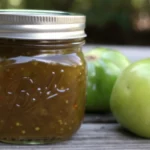
Homemade Tomato Jam: Turn Green Tomatoes into Liquid Gold
- Total Time: 2 hours
- Yield: 8–10 half-pint jars 1x
Description
This comprehensive green tomato jam recipe turns unripe end-of-season tomatoes into a gourmet preserve. With its sweet-tart flavor profile and aromatic spices, it’s a versatile condiment perfect for both sweet and savory dishes.
Ingredients
- 6 pounds green tomatoes (about 24 medium)
- 5 cups granulated sugar
- 1/4 teaspoon ground cinnamon
- 1/8 teaspoon ground cloves
- 1 medium lemon, thinly sliced
- 2 tablespoons distilled white vinegar
- Optional: 1 tablespoon fresh ginger, minced
- Optional: 1/2 teaspoon vanilla extract
- Optional: Pinch of red pepper flakes
Instructions
- Prepare canning station: sterilize jars and lids.
- Core and halve tomatoes, then chop or pulse in processor.
- Combine tomatoes, sugar, cinnamon, cloves, and lemon in pot.
- Bring to rolling boil for 25 minutes, stirring frequently.
- Reduce heat and simmer 30 minutes until thickened.
- Ladle jam into jars, leaving 1/4-inch headspace, remove air bubbles.
- Seal jars with lids finger-tight.
- Process jars in boiling water bath 20 minutes.
- Cool jars on towel-lined surface for 12–24 hours.
- Test seals before storing.
Notes
For variation, substitute sugar with honey, add apples or pears for natural pectin, or enhance flavors with herbs like basil or rosemary.
- Prep Time: 30 minutes
- Cook Time: 55 minutes
- Category: Preserves
- Method: Canning
- Cuisine: American
Nutrition
- Serving Size: 2 tablespoons
- Calories: 141
- Sugar: 35g
- Sodium: 12mg
- Fat: 0.3g
- Saturated Fat: 0.03g
- Unsaturated Fat: 0.13g
- Trans Fat: 0g
- Carbohydrates: 36g
- Fiber: 1g
- Protein: 1g
- Cholesterol: 0mg
